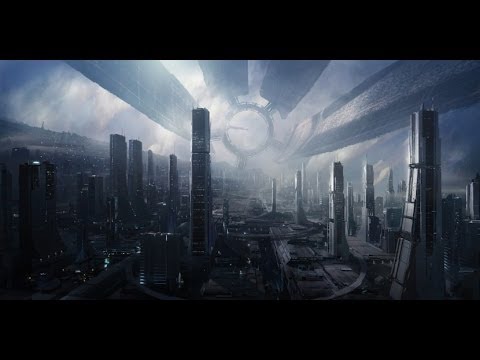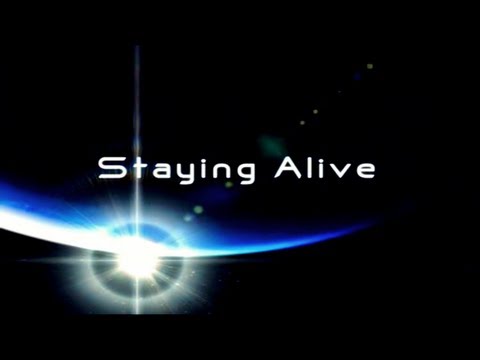Wormhole Theory Explained – Breaking Spacetime!
Do wormholes really exist like we think they do? And what are they really like if so? Join me as we explore the Wormhole Theory! So if you’ve watched any kind of sci-fi show that dealt with space travel and such, you more than likely have heard of the concept of wormholes. To put it in the most basic of terms, wormholes are “shortcuts” in the universe. You go in through one side of the universe, and you come out in an area that is REALLY far away from where you were just a few minutes ago. Star Trek Deep Space Nine based an entire series on a space station that protected a wormhole that led to another quadrant of space. But are these things really possible in our own universe? And if they were, wouldn’t we have found one yet? The answers may surprise you, especially when you hear that wormholes were speculated upon by one of the most brilliant minds in the world…Albert Einstein. In 1935, Einstein and Nathan Rosen illustrated the idea through the theory of general relativity, proposing bridges across space-time, connecting two different points of space-time, and theoretically creating a shortcut that could reduce travel distance and time. Einstein-Rosen ”or“ wormholes ”. Einstein’s theory of scientific relativity mathematically predicted the existence of wormholes, but no wormholes have been discovered so far. Some equations suggest the existence of wormholes with mouths that are black holes, but obviously we can’t prove whether a black hole is a wormhole because things and objects and people that go into black holes…well let’s just say that it doesn’t end well for them and move on. What this really boils down to though is the concept of space-time, which Albert Einstein theorized was the forces of space and time together in a “fabric” if you were that made up the entire universe. And the reason the Earth, sun, and galaxies are able to do certain things in the universe (like cause orbits of moons and planets and stars) isn’t because of gravity per se, but rather, because they are able to manipulate the space-time around them into “valleys” that cause things to rotate around them because they get trapped into that valley. Due to this, Einstein speculated that space-time could be stretched, warped, depressed, and yes, even torn into. Which is where the original notion of the wormhole came from. Because if you open a “hole” in space-time…there has to be something else on the other side, right? Believe it or not, Einstein and others have noted that there are potentially 5 different kinds of wormholes. Here are some basic explanations of each: Traversable Wormholes: These wormholes are the most famous, especially in science fiction movies, holes through which they cross at a point in the universe to get out of somewhere else. Not unlike the Star Trek Deep Space Nine wormhole. Non-Traversable Wormholes: Nothing can cross, either because these worm holes fall apart (may contain an inlet point without an outlet), or to sabotage the particles before they reach the other end. One-Way Wormholes: You can travel through one wormhole and need another wormhole to return. In one of the solutions of Einstein’s equation, it turns out that wormholes can be found in black holes but are not crossable. White holes have a role in wormholes. They are the opposite of black holes where they ejaculate matter with enormous force. Two-Way Wormholes: This type of wormholes is the same way back and forth. Intra-Universe: These holes are located in our universe and are to travel from one point within our universe to another point. Inter-Universe: These wormholes connect our universe to another parallel universe. You can see DC Comics or Marvel for these very unique kind of “crisis” wormholes. So right there are many different kinds of wormholes and the impact that they could have on the universe and the people living within the universe at large. Which leads us to the big question, “Where are the wormholes in our universe right now?” Well, we’ve already talked about that a little in that there are a lot of theoretical wormholes in the universe via black holes, white holes, and other massive galactic entities…but…they’re only theoretical at present. To be clear, that doesn’t mean that they DON’T exist, but it’s another case of, “It could be real…and it could not.” This is the type of thinking behind another cosmic theory and mystery known as Dark Matter and Dark Energy. But that’s another topic entirely. Not unlike many good theories, there is math, science, and physics that back up the possibility of this being real, including the aforementioned Theory of General Relativity. But just because something CAN happen…doesn’t mean it does happen. We’ve proven that on Earth more times than you can likely count just with our daily lives. Not to mention, while the Theory of Relativity is a profound piece of math that helps describe various things, and is widely accepted as being true…it’s still just a theory. And if you were to dive deep into the math, you’d see that things within it are open to various interpretations and have multiple possible outcomes in regards to reality as a whole. Meaning that there are multiple ways to view these numbers, and wormholes are only one of those answers. Which is possibly why we have only dreamed and pictured wormholes and not technically found them. However, playing the devils’ advocate here, it could be that the circumstances of making a wormhole have not been met yet. In which a whole new possibility of why we haven’t found them is born. As Einstein theorized, the wormholes are breaches within the fabric of space-time, but it’s possible that nothing in the universe has been able to breach that fabric. That’s not saying it can’t be done, just that it hasn’t. Ironically enough, there are some sci-fi TV shows and movies that talk about ships creating their own wormholes through space-time by breaching this fabric. So maybe the reason we haven’t found a wormhole yet is because we need to make one ourselves. Or, it could be that the wormholes are out there in space right now…and we just haven’t found them yet. “But how could we not notice a wormhole in space?” you might be asking right now. Well never forget that space is MASSIVE, trillions of lightyears long, and we’re only able to speculate and view a small part of it with only some regularity. Case in point, we’re able to find and view stars and planets in galaxies far away, but we’re still finding new moons on Saturn and Jupiter, which are only hundreds of millions of miles away. So how can we see one and not the other within a good amount of time? Because while there are many, MANY people looking into space, they can’t view EVERYTHING at all times. Even if the whole planet was a giant telescope or “space radar” system we create, we wouldn’t be able to observe everything at once at all times. And since the planet ISN’T that, we have to scale down our reach, and thus you see why certain things are missed. So why not wormholes? So if they are out there, when were they made? The most probable answer is the Big Bang, which is the theoretical event that scientists speculate was the birth of our universe. A moment in which an explosion of mass shot in all directions and created the building blocks of the universe via gasses, matter, and more. It took millions and billions of years to form what we have now according to the theory. But, that leaves a lot of times for certain “holes” in the universe to be formed. In fact, some speculate that because of the violent nature of the Big Bag that there are actually a plethora of wormholes in the universe right now, all connected to another wormhole via “cosmic strings” and they are just waiting to be found. Plus, you need to consider this from the cosmic scope of things. Let’s say that in the universe, the whole universe…there are 5 wormholes. Ones that have a way in and a way out. If you were to randomly place those wormholes in the universe, what is the likelihood of them landing by us? Or in a place that we can view? Would we even recognize them? Could we even see them in the darkness of space? Before we answer that question, be sure to like the video and subscribe to the channel! That way you don’t miss any of our weekly videos! If you think about Star Trek, their wormhole was only seen after someone approached it. And a stable wormhole was rare (such as in Star Trek The Next Generation where one collapsed after it being entered by a ship, leaving them stranded light years away), which was why the one by Deep Space Nine was so special. And so considering all of that, maybe the reason that we haven’t found a wormhole yet is because we don’t know where it is, and thus haven’t viewed it yet. Oh, and there are some who think that the center of the galaxies? That they’re wormholes and not black holes. Which if true, could mean that all the galaxies are connected by the “cosmic strings” I mentioned earlier, and thus are much more profound than previously thought. Here’s another thing that you need to consider, if a wormhole were to exist, could it truly just…exist? No, I’m not trying to be philosophical here, I’m being quite serious. Because think of the natures of wormholes as we depict them right now. They’re holes in space that connect two parts of space, and in most instances, they’re deemed “open” all the time. But there’s a force in the universe that would directly fight such a thing, right? It’s called, gravity. Now yes, we did discuss how the theory of relativity states that gravity isn’t a real force and that space-time is only manipulated into thinking that gravity is real, but there are plenty of reasons to think that gravity is a natural force so let’s just roll with it. So, if a hole in the universe was real, and it was just…there…would the universe itself just allow it to exist? More than likely not, the natural gravity of the universe and deep space would likely try and pull it shut. And if you don’t believe me, look at black holes. The black holes in the universe are able to subvert the natural forces of the universe to survive via its own massive gravity exertion. HOWEVER, not all black holes are able to do this. Many black holes that are created aren’t able to maintain themselves because of Hawking Radiation and other factors. And because of this, they die. Which is something we’ve proven ourselves here on Earth because humanity is able to make their own black holes…for all of a few seconds until the energy within them dies out. Thus, if a wormhole existed, the universe would try and seal it by making it close on itself in the middle, making it an event horizon, not unlike a black hole, and thus making it useless in all the ways that matter. Granted, we can prove this is what happened, however, if the wormholes were made in the Big Bang, and billions of years of force and gravity have happened since, it would work that they were closed by the time humanity got around to looking for them. Although, it should be noted that the “cosmic strings” we mentioned earlier are a possible reason why the wormholes do indeed exist and have stayed open. As the strings are able to continue to maintain them via energy, or particles, or even matter. Though again, it’s theoretical. But…let’s just have a little fun and ask ourselves the fun question, “What would it mean if wormholes were real?” Or, “what could humanity do if we were able to make wormholes and safely pass through them?” Both good questions. The answer to the first one is the most simple. If wormholes were real, even if they were somewhat distant from us, it would mean that there is a passageway to the universe at large that we can potentially travel to. So that when we reach it, we’ll be able to potentially go to the other side of the universe without having to travel that far. Even the warp engines of Star Trek had limits, which was why a stable wormhole was something that everyone wanted…and wanted to control. Having the universe at your beck and call is infinitely appealing, even if only from a scientific perspective in regards to studying what lies in galaxies we likely will never be able to reach. But let’s bring it closer to home now. IF we were able to make our own wormholes, we could potentially start the first human trek across the stars. Which is something that humanity right now is trying to do via the Mars missions. But imagine launching into space and creating a wormhole just outside of Earth’s gravity, and then in seconds being able to land on Mars. Think about how that would help the colony process, and all the time, effort, and money it would save in trying to make Mars a viable place to live. Plus, if we could do that for Mars, we could do that for places like Saturn’s moon Titan, or for Alpha Centauri (which many believe is the next great planet for people to live on) and so on and so forth. The wormhole is kind of like a cheat code for space travel. Because now, we wouldn’t need to build ships fast enough to reach a certain place in a certain amount of time, we’d just need them to withstand the wormhole and get through to the other side with everything intact. Which is a nice dream…but that’s all it is right now. A dream. One that has made many sci-fi nerds and scientists ponder with anticipation and wonder. Could we travel through wormholes in the future? Absolutely. But will we? Time will tell. Space-time that is. Thanks for watching everyone! What did you think of this look at wormholes? Were you surprised by the deep science and lore behind them? Did you learn something new? Let me know in the comments below, be sure to subscribe, and I’ll see you next time on the channel!













